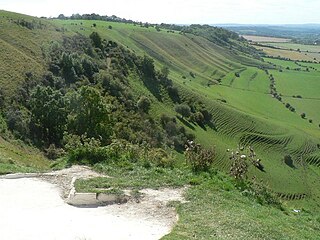
Blackmoor Copse is a woodland in southeast Wiltshire, England, managed as a nature reserve by the Wiltshire Wildlife Trust. The copse lies within Pitton and Farley parish, about 5+1⁄2 miles (9 km) east of Salisbury.
Gripwood Quarry is a 2.9 hectare geological Site of Special Scientific Interest in Wiltshire, England, notified in 1951. The quarry is of Oolitic limestone and has a wall in the middle creating an upper and a lower quarry, last used for mushroom growing. The walls are whitewashed and there is a large wooden crane.

Box Mine is a 56.6 ha biological Site of Special Scientific Interest, near the village of Box in Wiltshire, England, notified in 1991.
Acres Farm Meadow is a 4.2 hectare biological Site of Special Scientific Interest (SSSI) in Wiltshire, notified in 1989. It lies between the villages of Somerford Keynes and Minety. The SSSI is the former site of a mediaeval ridge and furrow system which lies on the Upper Jurassic Oxford Clay. The site is home to grasses, sedges and herbs. Trees such as oak, maple, English elm and hawthorn can be found in the hedgerows on the site, which provide nesting sites for lesser whitethroat, willow warbler, yellowhammer and bullfinch.
Baverstock Juniper Bank is a 2.6 hectare Biological Site of Special Scientific Interest to the north of the village of Baverstock in Wiltshire, England. Baverstock Juniper Bank is within the Cranborne Chase and West Wiltshire Downs Area of Outstanding Natural Beauty. The ungrazed chalk grassland is home to over 500 bushes of the lowland juniper, Juniperus communis, subspecies communis. Their seeds attract flocks of finches and yellowhammers to the location as a feeding site in winter. Uncommon species such a horseshoe vetch and pyramidal orchid are to be found at the SSSI. Butterflies such as the brimstone, speckled wood and small heath have been seen visiting the site.
Bencroft Hill Meadows is a 5.1 hectare biological Site of Special Scientific Interest some 3 miles (5 km) to the east of the town of Chippenham in Wiltshire, England, notified in 1988. The site is a flora-rich example of unimproved pasture on the Oxford Clay Vale of North Wiltshire which attracts butterflies such as the small copper, small heath and common blue.

Bratton Downs is a 395.8 hectare biological and geological Site of Special Scientific Interest in Wiltshire, England, near the villages of Bratton and Edington, and about 3 miles (5 km) east of the town of Westbury. It was notified in 1971. The designated area consists mainly of chalk grassland, as well as some ancient woodland, and supports a diverse range of native flora and fauna. It overlays notable geological features—principally landforms created by glaciation in the Pleistocene.
Calstone and Cherhill Downs is a 128.6 hectare biological Site of Special Scientific Interest in Wiltshire, notified in 1971, including downland at Calstone Wellington and Cherhill. It provides one of the best examples in Wiltshire of unimproved downland.

Botley Down is a biological Site of Special Scientific Interest in Wiltshire, notified in 1989.

Camp Down is a 7.3-hectare (18-acre) biological Site of Special Scientific Interest in Wiltshire in South West England. It was designated as such in 1965.
Brimsdown Hill is a 193.7 hectare biological Site of Special Scientific Interest in Wiltshire, notified in 1951. It is situated within the Cranborne Chase and West Wiltshire Downs Area of Outstanding Natural Beauty.j,
Distillery Farm Meadows is an 18.7 hectare biological Site of Special Scientific Interest in Wiltshire, notified in 1988.

Clattinger Farm is a 60.3 hectare biological Site of Special Scientific Interest in Wiltshire, notified in 1971.
Cockey Down is a 15.2 hectare biological Site of Special Scientific Interest in Wiltshire, notified in 1971.

Clout's Wood is an 11.78 hectare biological Site of Special Scientific Interest in Wiltshire, notified in 1951.
Cloatley Manor Farm Meadows is a 12.1 hectare biological Site of Special Scientific Interest in Wiltshire, notified in 1997.
Emmett Hill Meadows is a 5.1 hectare biological Site of Special Scientific Interest in Wiltshire, notified in 1987.
Great Cheverell Hill is a 33.2 hectare biological Site of Special Scientific Interest at Great Cheverell in Wiltshire, notified in 1971.
Hang Wood is a 20.3 hectare biological Site of Special Scientific Interest in Wiltshire, notified in 1986.
Harries Ground, Rodbourne is a 6.87 hectare biological Site of Special Scientific Interest in Wiltshire, England, notified in 2003. It lies to the south of Rodbourne in north Wiltshire, about 3 miles (5 km) south of Malmesbury.
This page is based on this
Wikipedia article Text is available under the
CC BY-SA 4.0 license; additional terms may apply.
Images, videos and audio are available under their respective licenses.






